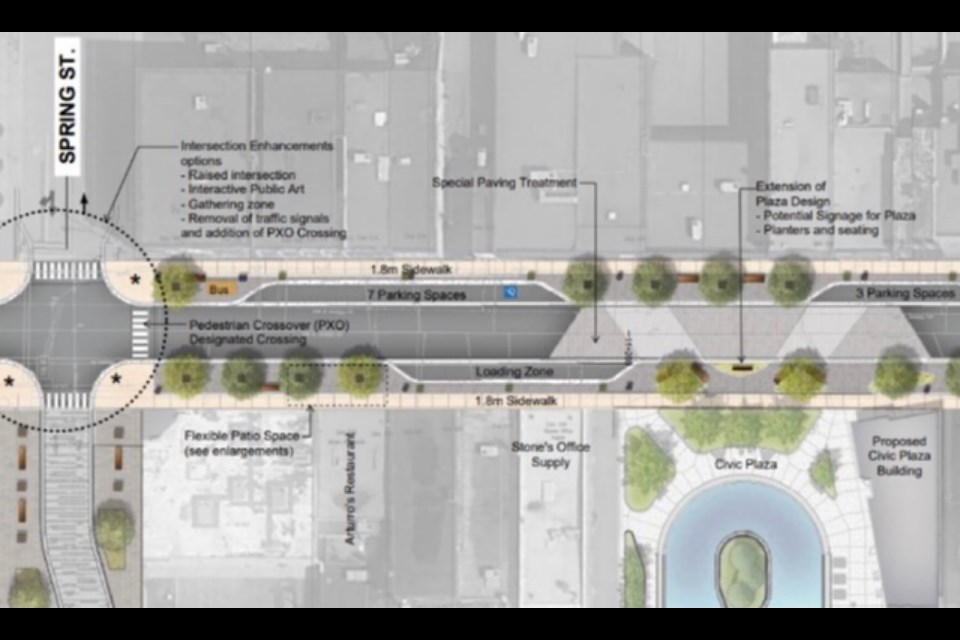Sault Ste. Marie city councillors are preparing to take another deep dive into a conceptual design for Queen Street between Pim and Gore.
Among other things, the city's preferred plan calls for a reduction of the downtown speed limit on a one-way, two-lane Queen Street to 30 kilometres an hour.
At Monday's city council meeting, the city's engineering staff will dig in their heels on most parts of their $18-million design, while Ward 1 Coun. Sonny Spina will push for changes.
Spina is planning to ask city staff for:
- a plan for two-way traffic on Queen Street
- a plan to remove all parking from Queen Street and move it to perpendicular streets and existing parking lots
- a plan to include areas for delivery vehicles to use side streets or cut-in sections on Queen Street in front of businesses
- a plan to increase the use of outdoor patios/commercial space for businesses
- a plan to use the existing infrastructure such as the Hub Trail and the Bay Street multi-use path, connecting links in the downtown core, back lots, and north-south streets to be identified as cycling/pedestrian routes to connect businesses and city services to the path moving them away from conflict with motor vehicles
- a plan to make downtown more friendly to pedestrians block by block to promote easier and multiple commercial visits
- a plan to use trial periods for ideas such as reduced speed limits, two-way traffic and cycle/pedestrian routes to gauge their success before implementing the full plan
- a plan to increase residential/rental housing units in the downtown core
"The 1.8-kilometre area of Queen Street East from Pim Street to Gore Street has not had a significant upgrade or change in almost 50 years," says Spina in his resolution, which will be seconded by Ward 1's Sandra Hollingsworth.
City staff are recommending that the Queen Street improvements be introduced over several years, beginning with the middle section from Bruce to Brock streets, to align with the opening of the downtown plaza.
That part of the project will cost about $6 million.
To city staff, the idea of reducing Queen Street to one lane is a non-starter because city buses, delivery vehicles, and emergency services would bring traffic to a full stop.
Staff say they are willing to explore further discussion about temporary closure of lanes for additional width for bicycles and pedestrians.
They also will argue on Monday that making Queen Street a two-way street would require them to re-open an environmental assessment study done in 2017.
That would require more public consultations, re-examining alternatives and re-posting a new preferred alternative.
City staff recommendations for Queen Street improvements will be included in a five-year capital transportation program to be presented at city council's meeting on Aug. 28.
Meanwhile, there's increased talk around the civic centre about another downtown initiative: turning Spring Street into a woonerf: a pedestrian-friendly street where pedestrians and cyclists share the same right of access to the road as vehicles, which are required to move at walking speed.
Spring Street is key to the city's wish to link the waterfront to the downtown commercial district on Queen.
This month, Carl Rumiel, city director of engineering and planning director Peter Tonazzo disclosed that the cost of the Spring Street woonerf is estimated at $3 million to $4 million.
For readers tracking how much cash the city is pouring into downtown, here's a tally of current and planned initiatives
- downtown plaza – $11.6 million
- Soo Mrkt move to Brock Street – $3 million
- Queen Street reconstruction – $18 million
- Spring Street woonerf – $3 million to $4 million
- TOTAL – Almost $37 million
Those numbers don't include $121 million in recent private-sector investments in our downtown, city officials point out.
Next week's city council meeting will be livestreamed on SooToday starting at 5 p.m. Monday.
